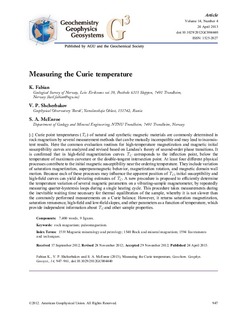| dc.contributor.author | Fabian, Karl | |
| dc.contributor.author | Shcherbakov, V. P | |
| dc.contributor.author | McEnroe, Suzanne | |
| dc.date.accessioned | 2018-03-23T12:21:33Z | |
| dc.date.available | 2018-03-23T12:21:33Z | |
| dc.date.created | 2013-06-17T13:25:39Z | |
| dc.date.issued | 2013 | |
| dc.identifier.citation | Geochemistry Geophysics Geosystems. G3. 2013, 14 (4), 947-961. | nb_NO |
| dc.identifier.issn | 1525-2027 | |
| dc.identifier.uri | http://hdl.handle.net/11250/2491932 | |
| dc.description.abstract | [1] Curie point temperatures (TC) of natural and synthetic magnetic materials are commonly determined in rock magnetism by several measurement methods that can be mutually incompatible and may lead to inconsistent results. Here the common evaluation routines for high‐temperature magnetization and magnetic initial susceptibility curves are analyzed and revised based on Landau's theory of second‐order phase transitions. It is confirmed that in high‐field magnetization curves TC corresponds to the inflection point, below the temperature of maximum curvature or the double‐tangent intersection point. At least four different physical processes contribute to the initial magnetic susceptibility near the ordering temperature. They include variation of saturation magnetization, superparamagnetic behavior, magnetization rotation, and magnetic domain wall motion. Because each of these processes may influence the apparent position of TC, initial susceptibility and high‐field curves can yield deviating estimates of TC. A new procedure is proposed to efficiently determine the temperature variation of several magnetic parameters on a vibrating‐sample magnetometer, by repeatedly measuring quarter‐hysteresis loops during a single heating cycle. This procedure takes measurements during the inevitable waiting time necessary for thermal equilibration of the sample, whereby it is not slower than the commonly performed measurements on a Curie balance. However, it returns saturation magnetization, saturation remanence, high‐field and low‐field slopes, and other parameters as a function of temperature, which provide independent information about TC and other sample properties. | nb_NO |
| dc.language.iso | eng | nb_NO |
| dc.publisher | American Geophysical Union | nb_NO |
| dc.title | Measuring the Curie temperature | nb_NO |
| dc.type | Journal article | nb_NO |
| dc.type | Peer reviewed | nb_NO |
| dc.description.version | publishedVersion | nb_NO |
| dc.source.pagenumber | 947-961 | nb_NO |
| dc.source.volume | 14 | nb_NO |
| dc.source.journal | Geochemistry Geophysics Geosystems | nb_NO |
| dc.source.issue | 4 | nb_NO |
| dc.identifier.doi | 10.1029/2012GC004440 | |
| dc.identifier.cristin | 1034671 | |
| dc.relation.project | Norges forskningsråd: 222666 | nb_NO |
| dc.description.localcode | ©2012. American Geophysical Union. All Rights Reserved. | nb_NO |
| cristin.unitcode | 194,64,90,0 | |
| cristin.unitname | Institutt for geovitenskap og petroleum | |
| cristin.ispublished | true | |
| cristin.fulltext | original | |
| cristin.qualitycode | 2 | |
